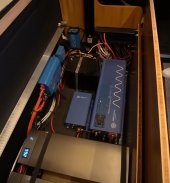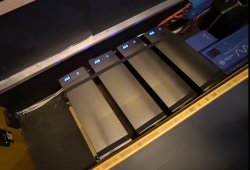Charleswgibbs
Solar Enthusiast
- Joined
- Aug 5, 2022
- Messages
- 261
Anyone have any guesses on how some people are able to accomplish high power alternator charging of 24v or 48v lifepo4 banks?
I've seen more than a few van tour videos of the high-end builders where they claim their electrical systems can do 3000w+ alternator charging on 24v or 48v banks, one was even claiming 6000w while driving.
Obviously they must be using high output secondary alternators, but when it comes to dc-dc chargers nothing on the market even comes close to those charging levels.
Victron's Orions max out at 15a for the 24v models and I don't believe they even make one capable of 48v output.
Sterlings are a bit more powerful but I believe their highest output is like 30a @24v and 15a @48v Their site mentions higher power models are coming, and I've seen a data sheet showing a 160a 12v-12v model, but the 24v and 48v models were still anemic.
Maybe they aren't using a dc-dc charger and instead are using 24v/48v alternators directly connected with some basic current limiting? Or maybe they have some as-of-yet released high power models? Maybe just exaggerating their vans capabilities? I doubt they are using 15 Orions or 6 sterlings ganged together.
I would ask in the comments on the videos, but every time I've ever asked technical questions in the past I get told I'm asking for secrets they can't divulge.
Thanks in advance for any ideas!
I've seen more than a few van tour videos of the high-end builders where they claim their electrical systems can do 3000w+ alternator charging on 24v or 48v banks, one was even claiming 6000w while driving.
Obviously they must be using high output secondary alternators, but when it comes to dc-dc chargers nothing on the market even comes close to those charging levels.
Victron's Orions max out at 15a for the 24v models and I don't believe they even make one capable of 48v output.
Sterlings are a bit more powerful but I believe their highest output is like 30a @24v and 15a @48v Their site mentions higher power models are coming, and I've seen a data sheet showing a 160a 12v-12v model, but the 24v and 48v models were still anemic.
Maybe they aren't using a dc-dc charger and instead are using 24v/48v alternators directly connected with some basic current limiting? Or maybe they have some as-of-yet released high power models? Maybe just exaggerating their vans capabilities? I doubt they are using 15 Orions or 6 sterlings ganged together.
I would ask in the comments on the videos, but every time I've ever asked technical questions in the past I get told I'm asking for secrets they can't divulge.
Thanks in advance for any ideas!




